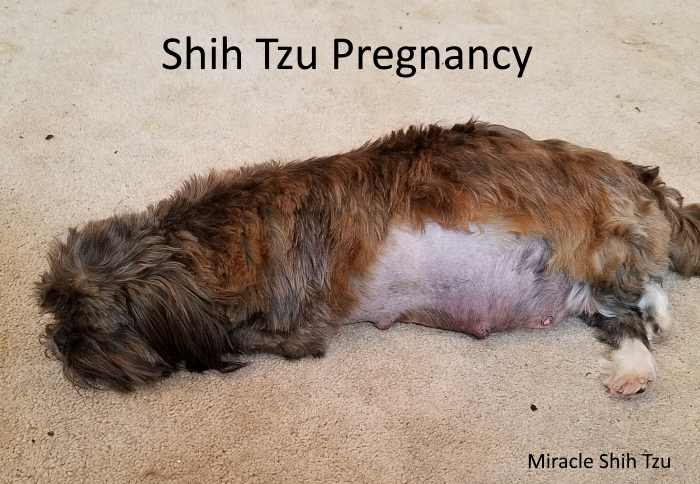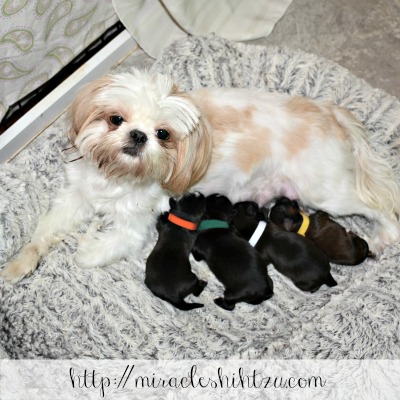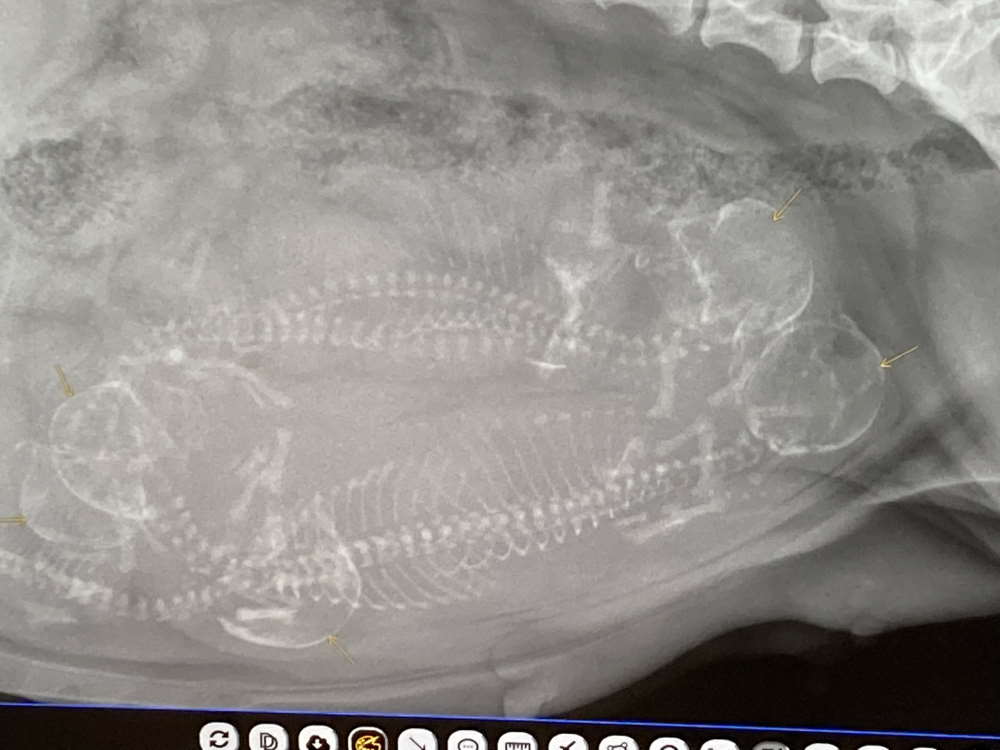- Home
- Breeding Dogs
- Shih Tzu Pregnancy
Your Guide to a Shih Tzu Pregnancy Week-by-Week
Shih Tzu Pregnancy by Janice Jones M.A.
Did you find yourself on this Shih Tzu Pregnancy page because you want to breed your Shih Tzu or think your baby may be pregnant? Perhaps you are just curious. Well, you are in the right place.
I've experienced hundreds of pregnancies, some uneventful, others that caused me concern, and others that were heart-wrenching.
Bringing a litter of puppies into the world is a fantastic experience. I do hope if you are here, you've made a conscious decision to breed your girl, and now you may want some answers and guidance on how to proceed.
I'm always so happy to help new or one-time breeders fulfill their desire to create a new family of Shih Tzu puppies. In this article, we are going to look at the stages of pregnancy, week by week.
Disclosure: This article contains affiliate links. If you purchase through them, I may receive a small commission at no extra cost to you. As an Amazon Associate, I earn from qualifying purchases. Thank you for supporting Miracle Shih Tzu!
 Gabby is a female Shih Tzu ready to whelp a litter in just a couple of days. This Shih Tzu pregnancy resulted in five healthy puppies.
Gabby is a female Shih Tzu ready to whelp a litter in just a couple of days. This Shih Tzu pregnancy resulted in five healthy puppies.How to Calculate the Due Date
There
are ways to help determine the whelping date, usually within a day by doing
progesterone testing or vaginal smears.
According to the AKC website, a dog pregnancy can last from ...
56-58 days from the first day of diestrus
64-66 days from the initial rise in progesterone
58-72 days from the first time the bitch, aka Mama allowed mating to occur.
For the Shih Tzu breeder, the best way to handle the questions is when you expect the litter to be born. I recommend giving them a time frame of about a week (for example, The second week in August)
As a new (or experienced Shih Tzu breeder, you may want to download our perpetual Whelping Calendar to keep handy to estimate the time of your new litter.
 A typical Shih Tzu Pregnancy lasts 63 days and produces four puppies.
A typical Shih Tzu Pregnancy lasts 63 days and produces four puppies.Shih Tzu Pregnancy Week-by-Week Overview
Your little girl has mated, and now it is time to consider what comes next. It may only last nine weeks, but so much happens in those short weeks. I’ve assembled a list of events you can expect and what you can do to support your Shih Tzu. I’ve also included these events in a free download. Find that link to the download at the end of this article.
Week 1 (Days 1-7) - Fertilization & Early Changes
What’s happening with your Shih Tzu and Puppies
- Fertilization occurs after mating.
- The fertilized eggs travel toward the uterus and eventually embed into the uterine wall within a week.
- There are no visible physical changes with the mom.
- Some dogs experience a slight decrease in appetite or mild nausea due to hormonal changes.
- You may notice some Increased affectionate behavior in some dogs.
What can you do as the Breeder
- Maintain a healthy diet, but do not increase food intake yet.
- Avoid stress and excessive physical activity. Regular exercise is fine and should be encouraged.
- Ensure normal hydration
Week 2 (Days 8-14) - Embryo Development Begins
What’s Happening with your Shih Tzu and Her Puppies
- The fertilized eggs implant into the uterine wall.
- The embryos begin forming essential organs.
- Mild morning sickness in some Shih Tzus, so don’t panic if your Mom feels sick.
- Slight decrease in energy levels.
- Appetite may start to increase slightly after nausea subsides
What can you do
- Avoid strenuous exercise but allow normal activities.
- Feed high-quality protein food to support embryo development.
- Avoid medications unless prescribed by a vet.
Week 3 (Days 15-21) - Hormonal Shifts & Embryo Growth
What is happening with your Shih Tzu and Puppies
- Embryos continue developing rapidly.
- The placenta forms to nourish the puppies.
- Swollen nipples may start to appear.
- Increased appetite.
- Behavioral changes occur, including clinginess, seeking solitude, or alternating between the two.
What you can do
- Keep feeding portions regular but nutritious.
- Continue gentle exercise to maintain health.
- Monitor for signs of morning sickness (vomiting, fatigue).
Week 4 (Days 22-28) - Puppy Development & First Vet Check-up
What’s Happening with your Shih Tzu and Puppies
- The brain and spinal cord begin to develop.
- The embryo begins to curl up in that classic fetal position.
- All organs, the limbs, eyes, and face are forming.
- By the end of this period, the embryo is oval and about an inch in diameter.
- The Mom’s abdomen may start to enlarge slightly.
- She may have a clear or milky vaginal discharge, which is normal.
- Nipples become more prominent
What you can do
- First vet visit! Your vet can confirm pregnancy via ultrasound by the end of this week.
- Start feeding slightly larger portions with high-protein food.
- Avoid stress and strenuous activity.
Week 5 (Days 29-35) - Puppies Begin to Take Shape
What is happening with your Shih Tzu and the puppies
- Fetuses develop facial features, paws, and organs.
- Sexual characteristics begin to show,
- Eyelids close
- Bones begin hardening, and movement starts.
- Noticeable increase in belly size, especially if Mom is having a large litter.
- Increased hunger due to rapid puppy growth.
- Possible weight gain and mild discomfort.
What can you do
- Switch to high-calorie, nutrient-rich dog food.
- Avoid raw food to prevent bacterial infections.
- Be sure that your Shih Tzu has fresh water at all times.
- Gentle belly rubs and comfort measures help ease discomfort.
Week 6 (Days 36-42) - Puppies Grow Fur & Movement Increases
What is Happening with your Shih Tzu and the Puppies
- Whiskers, claws, and fur begin forming on the puppies.
- The fetuses become active, and you may feel movement.
- Noticeable weight gain and a larger belly.
- Puppy movements may be felt, but don’t panic if you can’t feel any movement.
- Increased nesting behavior (seeking cozy dark areas such as under the bed or other furniture, inside of closets, or other places. She is looking for a place to give birth (Whelp).
What can you do
- Increase meal portions.
- Provide a soft bedding area for comfort, especially where you want her to whelp, but you don’t need a whelping box just yet.
- Provide TLC as much as possible and try to keep anxiety at a low level
- Avoid handling the belly too much to prevent stress.
Week 7 (Days 43-49) - Preparing for Birth
What is Happening with your Shih Tzu and the Puppies
- Puppies continue to grow, and their lungs develop for breathing.
- The bones are now calcified so they can be seen on x-rays.
- The fetuses continue to grow and increase in weight.
- The mother begins preparing for whelping (giving birth). This can include looking for a special place to give birth, as I described above. Scratching or digging into the floor, carpet, or furniture is her way of creating a nest. If you don't want her to do this, prepare the whelping box with plenty of old towels or blankets so you can nest in the actual place where she will give birth.
- More restless or anxious behavior. She may not sleep as long as she did before getting pregnant.
- Reduced appetite due to space occupied by puppies.
- Nipples may leak colostrum, a thin milky fluid. This is the first milk the puppies consume after they are born that is vital.
 The easiest way to count the number of unborn puppies is to locate and count skulls. Some vets also have the ability to measure the size of the skull and compare the diameter to that of the birth canal. This is helpful when deciding whether a c-section will be necessary.
The easiest way to count the number of unborn puppies is to locate and count skulls. Some vets also have the ability to measure the size of the skull and compare the diameter to that of the birth canal. This is helpful when deciding whether a c-section will be necessary.What you can do
- Prepare a whelping box in a quiet, warm place.
- Assemble your supplies.
- Provide smaller, frequent meals.
- Start monitoring temperature (normal: 101-102°F)
- When her temperature drops below 100°F, whelping will likely occur within the next 24 hours.
Week 8 (Days 50-56) - Nesting & Final Preparations
What is Happening with your Shih Tzu
- Puppies are fully formed but still developing lung strength.
- The mother may start nesting behavior aggressively.
- Heavy breathing, some panting, and discomfort.
- Loss of appetite.
- Milk production increases.
What you can do
- Keep her comfortable and relaxed.
- Don’t force her to eat, as she likely won’t want to eat.
- Ensure constant access to fresh water.
- Check the temperature twice daily to plan when whelping will occur.
- You may be able to hear fetal heartbeats if you have a pediatric stethoscope. The adult dog is between 70 – 120 beats. Fetal heart beat is 170 to 230 beats per minute.
My favorite canine thermometer for whelping is a rectal one, as it is the most accurate.
Digital Pet Thermometer on AmazonWeek 9 (Days 57-68) – It is time to Whelp
What is Happening with your Shih Tzu
- Labor begins – Shih Tzus can give birth anytime now.
- Puppies move into the birthing position. Not all puppies will be born headfirst. It is usual for some to be born in a breach position.
- Drop in body temperature (below 99°F = labor in 12-24 hours). Remember if this happens in the late afternoon or early evening, whelping will occur during the middle of the night. Plan accordingly.
- Refusing food and restlessness.
- Pacing, whining, or digging at bedding.
- Shivering and licking the vulva.
What you can do
- Supervise closely, but don’t interfere unless needed.
- Provide comfort and calm to reduce the anxiety level.
- If strong contractions last more than 30 minutes with no puppy, call the vet.
- Keep the whelping area warm and quiet.
Warning Signs to Watch For
Call a vet immediately if you notice:
- Green or foul-smelling discharge before birth.
- Excessive vomiting or lethargy.
- Straining for 1+ hours with no puppy delivery.
- Excessive bleeding post-birth.

Last Words
The Shih Tzu Dam is pregnant for about 9 weeks, approximately 58 to 68 days. The early signs of pregnancy that you may be able to observe are behavioral changes, appetite changes, and slight nipple enlargement. Don’t be surprised if you don’t notice these changes. Her appetite may diminish if she has morning sickness, but this only lasts a few weeks.
By the fourth week, the fetuses can be observed by ultrasound, so you may want to schedule an appointment with your vet or a vet using this technology. At this point, you can determine how many puppies your dog will have. You may notice that your sweet Shih Tzu girl gets feisty and irritable.
Some Shih Tzu dogs want to be left alone, and others are incredibly clingy. You will be able to see increased growth, and you will need to provide more food.
By the seventh week, it is time to begin preparation for birth or whelping. Assemble the supplies you will need. Keep your vet’s telephone number in a prominent location.
After the eighth month, you can schedule an x-ray to determine how many puppies there are and whether they can pass easily through the birth canal. By the ninth week, it is almost time, so you should ensure that everything is ready for the big day.
Shih Tzu Pregnancy: Week-by-Week: Pin for Future Reference
"Hi, I'm Janice Jones, a former veterinary technician and Shih Tzu expert with over 40 years of experience with the breed. Through Miracle Shih Tzu, I combine my medical background and extensive breed knowledge to provide reliable, practical advice for Shih Tzu owners. My mission is to help you give your Shih Tzu the happiest, healthiest life possible through evidence-based information and real-world solutions. Whether you're new to the breed or a seasoned owner, you'll find trusted guidance here for all aspects of Shih Tzu care.
I hold an undergraduate degree in Psychology with a minor in biology, Early Childhood Education, and Nursing, and a Master's in Mental Health Counseling.




